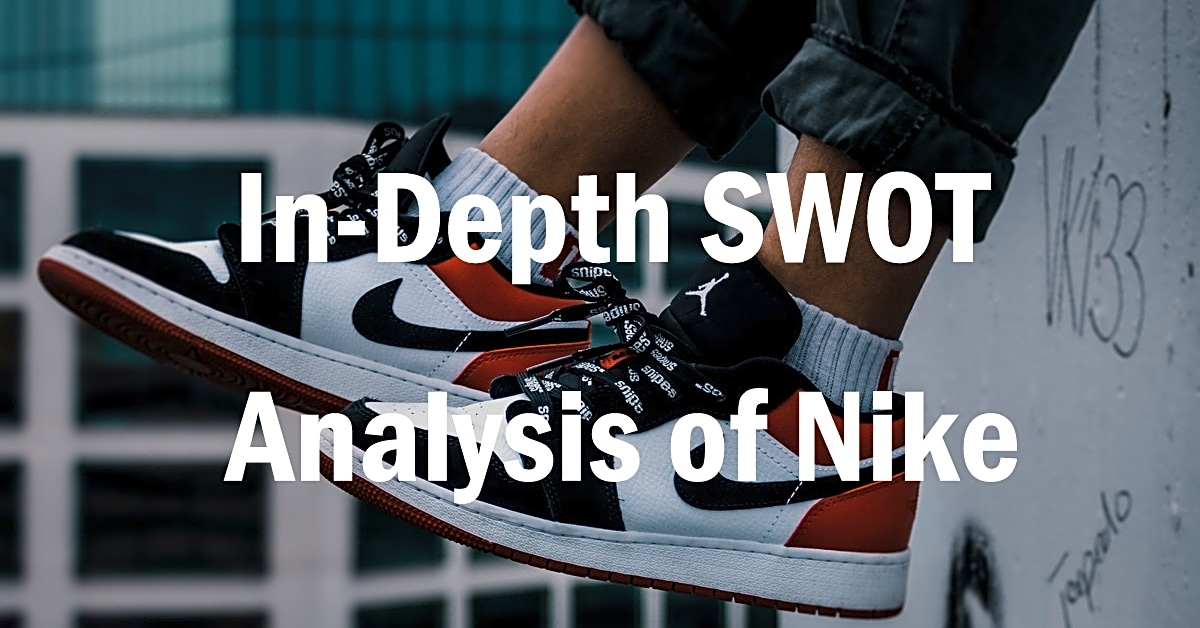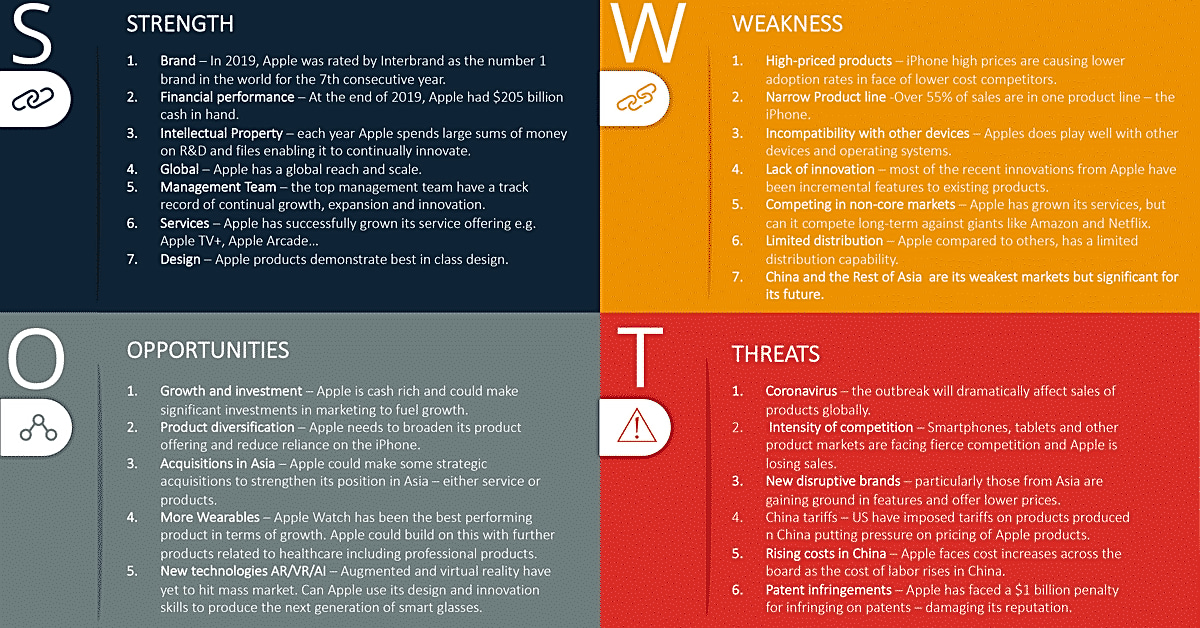Nike is a global leader in the athletic footwear and apparel industry, known for its innovative designs and high-quality products. The company was founded in 1964 by Bill Bowerman and Phil Knight, and has since become one of the most recognized and valuable brands in the world. Nike’s success can be attributed to its strong brand image, extensive product line, and effective marketing strategies. In this article, we will delve into the company’s strengths, weaknesses, opportunities, and threats through a comprehensive SWOT analysis. This analysis will provide valuable insights into Nike’s current position in the market and its potential for future growth. Whether you are a business student or a fan of the brand, understanding Nike’s SWOT analysis will give you a deeper appreciation for the company’s success. So let’s dive into the world of Nike and explore its strengths, weaknesses, opportunities, and threats in detail.
To begin, let’s define what a SWOT analysis is and how it can be conducted. A SWOT analysis is a strategic planning tool used to evaluate the internal and external factors that affect an organization. It stands for strengths, weaknesses, opportunities, and threats. By identifying these factors, a company can develop strategies to capitalize on its strengths, address its weaknesses, take advantage of opportunities, and mitigate potential threats.
Now, let’s take a closer look at Nike’s SWOT analysis. As one of the world’s leading sports brands, Nike has a strong brand image and a large global presence. This is one of their strengths that have contributed to their success. However, they also face challenges such as competition from other brands and changing consumer preferences. These are some of their weaknesses that they must address to maintain their market share.
Moving on to opportunities, Nike has the chance to expand into emerging markets and diversify their product offerings. They have also been investing in technology to enhance their products and customer experience. On the other hand, they face threats such as economic fluctuations and counterfeit products that could damage their reputation.
In conclusion, Nike’s SWOT analysis shows us that while they have a strong brand and global presence, they also face challenges that they must address. By using this analysis, Nike can continue to grow and maintain its position as a leader in the sports industry.
Nike’s Weaknesses
Competition and changing consumer preferences
Nike faces stiff competition in the athletic apparel and footwear industry, with major players such as Adidas, Under Armour, and Puma. These competitors offer similar products and have strong brand recognition, making it challenging for Nike to maintain its market share. Additionally, there has been a shift in consumer preferences towards athleisure wear and sustainable fashion, which could pose a threat to Nike’s traditional athletic products.
Nike’s Strengths
Nike’s brand image and global presence are two of the company’s greatest strengths. Nike has successfully established itself as a leader in the athletic apparel and footwear industry, with a strong reputation for quality and innovation. The iconic Nike swoosh logo is instantly recognizable worldwide, representing the company’s commitment to excellence and performance. This strong brand image has helped Nike maintain a loyal customer base and attract new customers through effective marketing strategies. Additionally, Nike has a strong global presence, with a presence in over 190 countries and a well-established distribution network. This allows the company to reach a wide range of consumers and tap into new markets, contributing to its continued growth and success. With its strong brand image and global presence, Nike is well-positioned to maintain its position as a top player in the competitive athletic apparel market.
Nike’s Threats
Nike, being a global brand, faces a number of threats in the market. Two major threats that have the potential to impact the company’s performance are economic fluctuations and counterfeit products.
Economic fluctuations can have a significant impact on Nike’s business, as it heavily relies on consumer spending. During times of economic downturn, consumers tend to cut back on their discretionary spending, which can result in a decline in Nike’s sales. In addition, currency fluctuations can also affect Nike’s profitability, as it sources materials from different countries and sells its products globally.
Another threat that Nike faces is the prevalence of counterfeit products. As a popular and highly desirable brand, Nike is often targeted by counterfeiters who produce and sell fake versions of its products. These counterfeit products not only hurt Nike’s sales and reputation, but they also pose a safety risk for consumers. Consumers may unknowingly purchase these fake products, thinking they are getting a good deal, but end up with poor quality items that may even be hazardous.
Nike’s Opportunities
use HTML structure with expansion into emerging markets and investment in technology only for main keywords and
Nike has been able to maintain its position as a global leader in the athletic apparel market by constantly seeking new opportunities for growth and expansion. One of these opportunities is expanding into emerging markets, such as China and India. These markets have a growing population of young, health-conscious individuals who are willing to spend on high-quality athletic products. By entering these markets, Nike can tap into a new customer base and increase its revenue.
In addition to expanding into emerging markets, Nike has also been investing heavily in technology. With the rise of e-commerce and digital marketing, Nike has recognized the importance of staying ahead of the curve and embracing new technologies. The company has been investing in areas such as artificial intelligence, data analytics, and virtual reality to enhance the customer experience and drive sales. By embracing technology, Nike can continue to innovate and adapt to changing consumer behaviors.
do not use “newline character”
Nike’s Strengths
Brand image and global presence
Nike is a household name in the world of sports and athletics, known for its high-quality products and innovative designs. The company has built a strong brand image over the years, making it one of the most recognized and trusted brands in the industry. This has helped Nike establish a loyal customer base and gain a competitive edge in the market.
Moreover, Nike has a strong global presence, with operations in over 170 countries and a network of retail stores, distributors, and online platforms. This allows the company to reach a diverse customer base and expand its market share worldwide.
Nike’s Weaknesses
Nike’s Weaknesses can be attributed to two main factors: competition and changing consumer preferences. As one of the leading athletic brands in the market, Nike faces stiff competition from other well-established companies such as Adidas, Puma, and Under Armour. These companies offer similar products and constantly innovate to stay ahead in the market.
Moreover, consumer preferences are constantly evolving, and Nike has to keep up with these changes in order to stay relevant. In recent years, there has been a shift towards more sustainable and socially responsible products, and Nike has faced criticism for its labor practices and environmental impact. This can be seen as a weakness for the company as it may lose customers who prioritize these values.
Nike’s Opportunities
Expansion into emerging markets: Nike has already established a strong presence in developed markets like the United States and Europe. However, the company sees a huge potential for growth in emerging markets like China, India, and Brazil. These markets have a growing middle class with increasing disposable income, making them attractive for Nike’s products. In fact, Nike’s revenue from emerging markets has been steadily increasing over the years, showing the success of its expansion strategy.
Investment in technology: Nike has always been at the forefront of innovation and technology when it comes to its products. The company continuously invests in research and development to improve its products and stay ahead of its competitors. For example, Nike has been investing heavily in digital technology, creating apps and wearable devices that enhance the customer experience. This not only helps in retaining customers but also attracts new ones, giving Nike a competitive edge in the market.
Nike’s Threats
Economic fluctuations and counterfeit products are two major threats that Nike faces in the market. These threats have the potential to impact the company’s sales and overall performance. Let’s take a closer look at each of these threats:
Economic Fluctuations: As a global brand, Nike is susceptible to economic fluctuations in different regions. In times of economic downturn, consumers tend to cut back on their spending, which can directly impact Nike’s sales. This was evident during the 2008 recession, where Nike’s sales were significantly affected. In addition, changes in currency exchange rates can also affect the company’s profits and margins.
Counterfeit Products: Another major threat for Nike is the sale of counterfeit products. As a popular and expensive brand, Nike is often a target for counterfeiters who produce fake versions of their products and sell them at lower prices. This not only affects Nike’s sales but also damages its brand reputation. Consumers who unknowingly purchase counterfeit Nike products may have a negative experience, which can lead to a loss of trust in the brand.
Nike’s Threats
use HTML structure with Economic fluctuations and counterfeit products for main keywords and
for paragraphs, do not use “newline character”
Nike’s Strengths
Nike’s brand image and global presence are two of its biggest strengths in the market. The company has established itself as a leader in the athletic footwear, apparel, and equipment industry, with a strong reputation for quality and innovation.
The Nike swoosh logo is instantly recognizable and has become synonymous with high-performance athletic gear. This strong brand image gives Nike a competitive edge over other companies in the industry, as consumers are willing to pay a premium for products that carry the Nike name.
Additionally, Nike has a strong global presence, with a presence in over 190 countries worldwide. The company has strategically expanded its operations to target emerging markets, such as China and India, which have significant growth potential. This global reach allows Nike to tap into a diverse consumer base and increase its market share.
Nike’s Weaknesses
Nike’s Weaknesses can be attributed to two main factors: competition and changing consumer preferences.
Firstly, Nike faces stiff competition in the athletic footwear and apparel industry. Competitors such as Adidas, Under Armour, and Puma have all carved out a significant market share, making it difficult for Nike to maintain its dominant position. This competition not only affects Nike’s sales and revenue but also puts pressure on the company to constantly innovate and improve its products to stay ahead.
Secondly, changing consumer preferences also pose a challenge for Nike. With the rise of athleisure and streetwear trends, many consumers are opting for more casual and comfortable styles rather than traditional athletic gear. This shift in preference has led to a decline in sales for Nike’s performance-based products, which make up a significant portion of their revenue.
Despite these weaknesses, Nike has been able to adapt and remain a top player in the industry. However, it is important for the company to continue monitoring and addressing these weaknesses in order to maintain its success.
Nike’s Opportunities
Nike has a strong presence in established markets such as North America and Europe, but the company also sees immense potential in emerging markets. With rising disposable incomes and a growing interest in fitness and sports, countries like China, India, and Brazil offer great opportunities for Nike to expand its reach and tap into new consumer bases.
To capitalize on this, Nike has been investing heavily in marketing and distribution strategies specific to these markets. The company has opened new stores, launched targeted advertising campaigns, and formed partnerships with local retailers to increase its presence in these regions. This focus on emerging markets has already paid off, with Nike reporting double-digit growth in revenue from these regions in recent years.
In addition to expansion into emerging markets, Nike is also investing heavily in technology to stay ahead of its competitors. The company has been at the forefront of incorporating technology into its products, with the introduction of features like Nike+ and self-lacing shoes. These innovations not only enhance the customer experience but also allow Nike to collect valuable data on consumer behavior and preferences.
Nike’s investment in technology also extends to its manufacturing processes. The company is continuously looking for ways to streamline production and reduce costs through automation and the use of advanced materials. This not only improves efficiency but also allows Nike to offer more innovative and sustainable products to its customers.
As we can see, conducting a SWOT analysis can provide valuable insights for a company like Nike. By identifying their strengths, weaknesses, opportunities, and threats, they can develop strategies to stay ahead of the competition and continue to thrive in the market. Whether you are a business owner or an individual looking to improve, understanding SWOT analysis can be a useful tool for personal and professional development.


